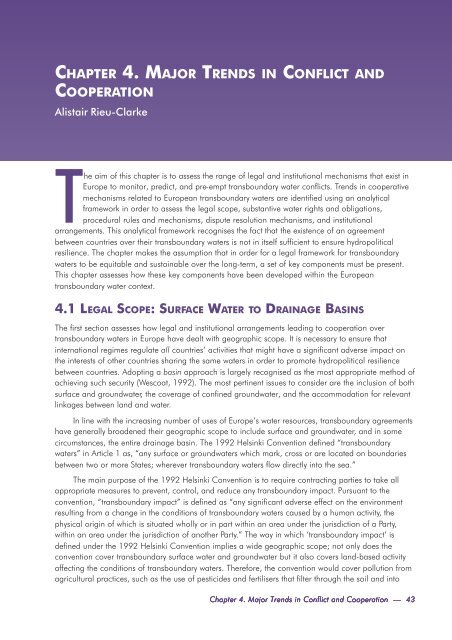Europe - UNEP
Europe - UNEP
Europe - UNEP
Create successful ePaper yourself
Turn your PDF publications into a flip-book with our unique Google optimized e-Paper software.
CHAPTER 4. MAJOR TRENDS IN CONFLICT AND<br />
COOPERATION<br />
Alistair Rieu-Clarke<br />
The aim of this chapter is to assess the range of legal and institutional mechanisms that exist in<br />
<strong>Europe</strong> to monitor, predict, and pre-empt transboundary water conflicts. Trends in cooperative<br />
mechanisms related to <strong>Europe</strong>an transboundary waters are identified using an analytical<br />
framework in order to assess the legal scope, substantive water rights and obligations,<br />
procedural rules and mechanisms, dispute resolution mechanisms, and institutional<br />
arrangements. This analytical framework recognises the fact that the existence of an agreement<br />
between countries over their transboundary waters is not in itself sufficient to ensure hydropolitical<br />
resilience. The chapter makes the assumption that in order for a legal framework for transboundary<br />
waters to be equitable and sustainable over the long-term, a set of key components must be present.<br />
This chapter assesses how these key components have been developed within the <strong>Europe</strong>an<br />
transboundary water context.<br />
4.1 LEGAL SCOPE: SURFACE WATER TO DRAINAGE BASINS<br />
The first section assesses how legal and institutional arrangements leading to cooperation over<br />
transboundary waters in <strong>Europe</strong> have dealt with geographic scope. It is necessary to ensure that<br />
international regimes regulate all countries’ activities that might have a significant adverse impact on<br />
the interests of other countries sharing the same waters in order to promote hydropolitical resilience<br />
between countries. Adopting a basin approach is largely recognised as the most appropriate method of<br />
achieving such security (Wescoat, 1992). The most pertinent issues to consider are the inclusion of both<br />
surface and groundwater, the coverage of confined groundwater, and the accommodation for relevant<br />
linkages between land and water.<br />
In line with the increasing number of uses of <strong>Europe</strong>’s water resources, transboundary agreements<br />
have generally broadened their geographic scope to include surface and groundwater, and in some<br />
circumstances, the entire drainage basin. The 1992 Helsinki Convention defined “transboundary<br />
waters” in Article 1 as, “any surface or groundwaters which mark, cross or are located on boundaries<br />
between two or more States; wherever transboundary waters flow directly into the sea.”<br />
The main purpose of the 1992 Helsinki Convention is to require contracting parties to take all<br />
appropriate measures to prevent, control, and reduce any transboundary impact. Pursuant to the<br />
convention, “transboundary impact” is defined as “any significant adverse effect on the environment<br />
resulting from a change in the conditions of transboundary waters caused by a human activity, the<br />
physical origin of which is situated wholly or in part within an area under the jurisdiction of a Party,<br />
within an area under the jurisdiction of another Party.” The way in which ‘transboundary impact’ is<br />
defined under the 1992 Helsinki Convention implies a wide geographic scope; not only does the<br />
convention cover transboundary surface water and groundwater but it also covers land-based activity<br />
affecting the conditions of transboundary waters. Therefore, the convention would cover pollution from<br />
agricultural practices, such as the use of pesticides and fertilisers that filter through the soil and into<br />
Chapter 4. Major Trends in Conflict and Cooperation — 43
















